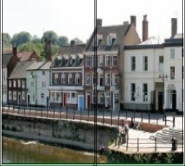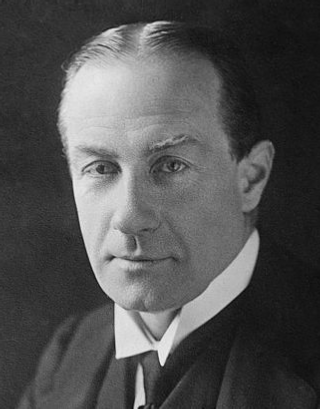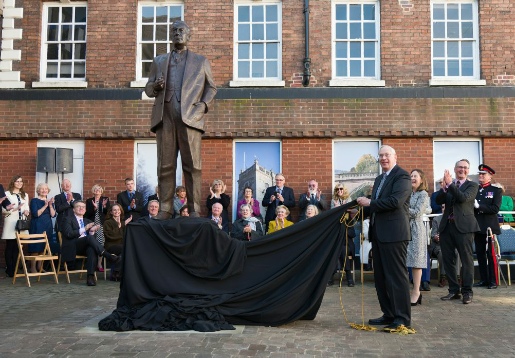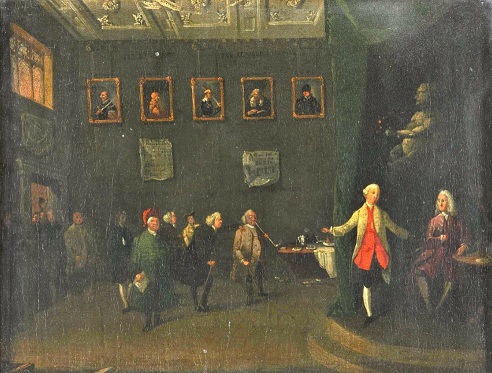












Bewdley Civic Society -
The early name for Bewdley is Wribbenhall, which is mentioned in the Domesday Book of 1086 as an “outlier” of Kidderminster and at that time, it covered both sides of the River Severn. By 1100 the king had used the river as a boundary and given the western side to the Mortimer family. He later gave Kidderminster (including what is now called Wribbenhall) to Manser Biset.
The Mortimers had territory extending deep into Wales and by 1270 appear to have seen their manor on the Severn as an important part of their communications network. Bewdley (the name Beaulieu means beautiful place) is first mentioned in 1275. It certainly had a ferry by 1336 (probably earlier), an official market by 1376 and was developing well as an inland port.
A boost to the town came in 1448 when a bridge was built over the river. This was in the turbulent period known as “The Wars of the Roses”. Bewdley was still a Mortimer manor and in the hands of Richard Duke of York (whose mother was a Mortimer). After his flight from Ludlow to York in 1459, it is possible Bewdley suffered at the hands of Lancastrian soldiers, as the bridge was reported as severely damaged and it is known that a spate of new house building occurred in the early 1460s.
Bewdley became a royal manor when Richard’s son became Edward IV and granted a charter (with special privileges and rights) in 1472 after, it is said, the inhabitants of Bewdley had done great service for the new king at the Battle of Tewkesbury the previous year. Richard III ensured the town had a new bridge in 1484.
Bewdley continued to be a royal manor under the Tudors. The Council of the Marches met here for six months of the year under Prince Arthur (the other six months being spent at Ludlow). The royal palace of Tickenhill (which had been re-
Wribbenhall continued to be part of the manor of Kidderminster and little is known of its early history. It does, however, have the oldest house, as Nos 5, 7 and 9 Stourport Road date from 1310. An even older building stands at Ribbesford. This area was “sub-
Bewdley’s 1472 charter was only the first in a long line of charters. More followed, granted by Henry VII, Henry VIII, James I, James II and Queen Anne. From 1606 the Borough had the right to return a Member to serve in Parliament. Bewdley has two maces from the time of Queen Anne; it is rare to have two, but not unique. Tickenhill ceased to be a palace once the manor was sold as a private house to Joseph Tangye. As there was no official manor house, William Nichols Marcy, a local solicitor and the Town Clerk who had acquired the Lordship of the Manor, took the opportunity of calling his residence in High Street “The Manor House” a name it still bears.
Wyre Forest lies to the north west of Bewdley and has been a significant factor in its growth. The Forest was a medieval hunting ground for the Mortimers, but also yielded timber for building and burning (especially charcoal production), with the bark being used in the tanning industry. The underlying coal measures were exploited by bell pits, evidence for which can still be found.
The river also meant Bewdley became a place of wealth. Boats went downriver with products from the forest, leather, horn and caps. Boats came upriver to disgorge their goods at Bewdley, where pack horses carried wares west into Wales and east to Birmingham and the Black Country. The bridge was the only one between Worcester and Bridgnorth, though there were several ferries to enable the river to be crossed. However, Bewdley was strategic in the system of communication and the point at which the river became more difficult to navigate going north. At one time, the Severn was the second busiest river in Europe, the Meuse being the busiest.
Thus the town flourished and many grew wealthy. Even the English Civil War of the 17th century had little impact on its prosperity. There was no serious decline until the early 19th century after a canal had been opened up at Stourport, creating that town and linking it with the industrial heartland of the Midlands. Bewdley was by-
The Severn Valley Railway was built in the 1850s with a station for Bewdley on the Wribbenhall side, but this new-
Bewdley and Wribbenhall were re-
Heather Flack
Stanley Baldwin
One of Bewdley’s most famous “sons” was Stanley Baldwin, who was born in Lower Park in 1867. He was its MP for 29 years and also served the nation three times as Prime Minister. He became Earl Baldwin of Bewdley in 1937.

On 27 September 2018, the historic town of Bewdley in Worcestershire was honoured by a visit from His Royal Highness The Duke of Gloucester., KG.

His Royal Highness unveiled a newly completed statue of Stanley Baldwin, the first Earl Baldwin of Bewdley KG (1867-
During his lifetime, Stanley Baldwin was regarded as one of Worcestershire’s two leading sons, the other being Sir Edward Elgar. He is recalled today with deep affection in his county, which well-
There are public memorials to Stanley Baldwin at Westminster. Now he is represented permanently in his own county among “my people”, as he referred to them.
Stanley Baldwin founded the Lord Baldwin Fund for Refugees raising some £500,000 to bring Jewish children (Kindertransportees) from Nazi Germany to Great Britain where they were placed with foster parents. Locally Stanley Baldwin became the first President of Stourport-
Baldwin was profoundly affected by the First World War and the sacrifices made during it by the men and women of his own county, and those of his country as a whole. In 1919 he gave a fifth of his wealth anonymously to the Treasury as a thank-
As Prime Minister he represented what came to be known as a “new conservatism”. Its central features were consensus, compassion and national unity. He detested class conflict and coined the term “One Nation”(wrongly ascribed to Disraeli), making spending on social services the largest item of government expenditure for the first time.
Widely read (Rudyard Kipling was his cousin), he was an inspired broadcaster in the early days of the BBC, adopting a relaxed, conversational style to stress the things that bound the nation together.
He venerated the Crown as the essential symbol of national unity. His skilful handling of the 1936 abdication crisis, which brought him immense praise, enabled the monarchy to survive its greatest crisis of modern times without damage.
Donations from many individuals and institutions made it possible to commission one of the country’s leading sculptors, Martin Jennings, who created the magnificent statue in bronze unveiled by His Royal Highness . The successful fund-
Oil on canvas, anonymous British school. An 18th century scene in Bewdley Town Hall depicting Wilson Aylesbury Roberts, Deputy Recorder, presenting George Lord Lyttelton, High Steward of Bewdley, to the Corporation. The Corporation is represented by seven men in the body of the hall with others in the doorway to the left. Picture by kind permission of Bewdley Museum.
More images of the past….

BEWDLEY CHERRY FAIR AND TRADITIONAL CHERRY GROWING.
THE RESCUE OF OLD CHERRY VARIETIES & MODERN CHERRY PRODUCTION.
Brian Stephens, July, 2020.
North Worcestershire has been noted for cherries since at least 1650. The Rev. Dr. John Beale FRS, (1608-
Cherries have always been a challenge to produce. Until about 1970 world production of sweet cherries relied on wild, vigorous root-
Cherry scions were not self-
Since the 1990s there has been much interest in the survival of old varieties of fruit, but cherries have received little attention. The Wyre Forest Study Group has played a part in these developments. Their study of local orchards, published by English Nature as Research Report Number 707,2006, was the first of its kind, confirming the value of orchards for wild-
Three innovations, since 1970, have re-
With this impetus for research and development both sweet and sour cherry production world-
The significance of the different sorts of cherry is not merely the names, but the distinct genetic make-
With the support of The Wyre Forest Study Group www.wyreforest.net and Bewdley Civic Society, www.bewdleycivicsociety.org.uk and others, with as much funding as possible, the Cherry Rescue Project aims to sample as many local cherry trees for DNA fingerprinting at East Malling, as funds allow. We are grateful to have received funding from the Helen Rachel Mackaness Trust to enable the DNA analysis and the identity of a 100 local cherry trees. This is an encouraging start for a long-
Brian Stephens, July, 2020.